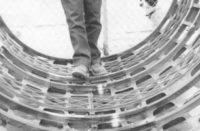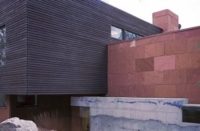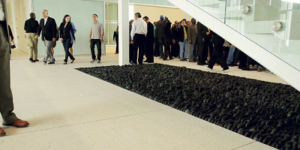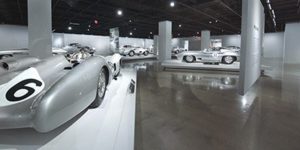As graceful as an acrobatic touchdown catch by Danny Abramowicz. As stunning as a Mel Blount goal-line interception. More sweeping than a Vida Blue curveball.
OK, we’re getting carried away with the sports analogies.
But after all, we are talking about the new Louisiana State Museum and Sports Hall of Fame. And its design, particularly the curvaceous, undulating surface of the interior, is extraordinary.
Located in the historic town of Natchitoches, said to be the oldest settlement in the Louisiana Purchase, the new space brings together collections formerly housed at a historic courthouse and a university.
The designer, Baton Rouge-based Trahan Architects, put cast-stone maker Advanced Architectural Stone to the test in the molding and casting of the concrete panels that produced the interior contours. From a surface model developed by the design team, Advanced Architectural Stone cast more than a thousand different panels, each one of a unique size and shape.
“The project required 1,064 pieces,” says Tim Michael, vice president, operations, of Advanced Architectural Stone, based in Fort Worth, Texas. “Every piece was different, with some as large as 18 by 12 1/2 feet.” Some of those larger pieces were produced for the uppermost section of the interior, near the skylight.
The parts were produced in four different phases, turning out 250 to 260 per phase.
“It was a lot of trial and error,” Michael says. The key was the creation of the molds for the individual panels. Advanced determined that a mold with a dense foam composition and a resin finish best served its purpose.
The geometry of the molds was specified by Case Design Inc., the New York-based Building Information Modeling (BIM) consultancy. Case, working for construction manager VCC, provided modeling services for precast panel construction, as well as electrical, HVAC and sprinkler systems.
Case created a model for each panel, and provided a shop ticket to Advanced for casting. Connection points were machined in to facilitate bolting to the metal frame of the interior design. Advanced made the molds using a five-axis CNC (computer numerical control) system that employed a laser to read the model. Each completed mold was digitally scanned and analyzed for compliance with the model.
Michael says the job was the first and only of its type for the company. The modeling process required more than a year to complete. Each mold required approximately two days to produce, with some parts taking more than a week.
For the mix, Advanced used a specially engineered combination of white cement, sand, admixtures and additives.
Advanced used the dry-tamp method to cast the concrete panels, employing low levels of water in the mix. Michael described the mix as “almost a wet sand,” and says the process offered a more economic and technically feasible method than conventional wet pour.
The finished panels were installed by Masonry Arts Co., of Bessemer, Alabama.
“The complexity was extensive,” says Trahan Architects president and principal in charge Victor F. “Trey” Trahan, discussing the processes used to make and install the panels. “Tolerances were very strict and limited, and installation and attachment to the structure was critical.”
Advanced Architectural Stone and the installation contractor Masonry Arts did a fantastic job, Trahan says. “For something that had never been done before, they achieved a remarkable quality level. All members of the design team applaud those efforts.”
Core of the design
The work of Advanced Architectural Stone won high praise from Trahan Architects as a key element in the designers’ concepts for the project.
Trahan says the architects sought more than the presence of interior walls to house a space — they wanted complex relief, a feeling of weight and mass, with the onlooker situated spatially in the core, in contrast to the effect of a meandering, shallow veneer.
The design represented an intent to contextualize the building in its landscape and environment, formed by an ancient river, Trahan says. Natchitoches is located alongside Cane River Lake, a body of water left by the Red River when the river changed course in the 19th century.
In addition to regional geology and geography, the design and material are intended as a reference to the area’s early architecture and construction, which employed a mixture of clay, Spanish moss and horsehair for walls and facades — a mixture called bousillage. “They would whitewash this monolith masonry, kind of like adobe. It’s something we wanted to connect with in a very contemporary way,” says Trahan.
The building’s relatively simple exterior of copper panels serves as a contemporary interpretation of the nearby area’s clapboard-and-shutter plantations, while the flowing interior “emerges at the entrance, enticing visitors to leave the walking tour and into the evocative exhibit spaces within,” Trahan Architects says in a description the firm released to the press.
Trahan says his team initially considered several material types, including plaster, metal, wood and fiberglass. “It was decided they didn’t have the material quality, the weight and mass.”
Trahan Architects calls the concrete-panel interior a “3-D jigsaw puzzle” of more than 1,000 pieces, each made individually from the digitally created pattern. “The puzzle can only be properly assembled if all the pieces are nearly perfectly made,” the press kit notes.
With the finished surfaces of the concrete panels, Trahan could achieve consistency, but with subtle differences in hues and tones. “In one way it’s a monolithic surface, but with the feeling and seeing of individual pieces. It’s the subtle variation we were looking for,” Trey Trahan says.
Complex array of connections
From a practical construction standpoint, the design team faced the challenge of making this weight and mass work. Some panels weighed as much as thousands of pounds.
A complex array of connections was employed to anchor the panels to the steel framework. Movement connections were required on most panels to account for shell action (sometimes called “arch action”) and the compressive strength of the cast stone. More than 20 different types of connections were used, depending on whether the panels were stacked, bolted up, hung, or attached by some hybrid mechanism. Some connections were accessible to welding and others “blind.” Some “completely unique” connections were developed on a case-by-case basis, Trahan Architects says.
Collaborating with Trahan Architects to map out this 3-D puzzle and its pieces were David Kufferman, a Fairfield, Connecticut, structural engineer, and Method Design, New York, using digital programs to determine final anchor points that Advanced Architectural Stone would need to machine into the panels. More than 2,150 such connection points were needed for the entire project.
Highly sophisticated software programs were utilized to map out the construction of the structure’s Shaped Surface Support Steel (SSSS) frame on which the cast stone panels were attached. Also impressive was the use of predeflecting ballast to install the cast-stone panels in the atrium and monumental stairway areas. This system used concentrated loads of 24 tons, hung from temporary frames, to account for deflection (displacement under a load) of the frame during construction.
The collaboration of all this technology and technical expertise produced, in the end, a resolution of Trahan Architects’ mission: to interpret athletics as a component of cultural history rather than as independent themes. “While sports and regional history may appeal to different audiences, the exhibits and configuration explore the interconnectedness between the two,” the architects propose in their written review. In this building, “the spaces flow visually and figuratively together.”
Project at a Glance
Client: Louisiana State Museum and Sports Hall of Fame, Natchitoches, Louisiana
Caster: Advanced Architectural Stone, Fort Worth, Texas | www.advancedarchitecturalstone.com
General contractor: VCC, Dallas, Texas | www.vccusa.com
Architect: Trahan Architects, Baton Rouge, Louisiana; Brad McWhirter, project architect | www.trahanarchitects.com
Concrete mix: Advanced Architectural Stone Inc., Fort Worth, Texas | www.advancedarchitecturalstone.com
Precast panel installation: Masonry Arts Co., Bessemer, Alabama | www.masonryarts.com
Building information modeling for precast panel construction: Case Design Inc., New York
Additional precast panel engineering and design: David Kufferman, P.E., Fairfield, Conn.; Method Design, New York
Steel fabrication and erection: Champion Steel, Alexandria, Louisiana, and CMC Steel, Cayce, South Carolina
White cement supplier: Lehigh White Cement, Waco, Texas
Scope of project: Design, manufacture, engineering, and construction of white-cement, molded cast stone panels for undulating, sinuous building interior; architecture described as an interpretation of the local area’s geology, geography and historical building construction
Project cost: $12.6 million
Project duration: 2 years, 8 months
Length of time for cast stone installation: 1 year, 6 months
Most challenging aspects: Design and manufacture of more than 1,000 unique customized concrete panels for building interior; Building Information Modeling (BIM) for construction of interior concrete panel system; installation of panels by means of various connection mechanisms; use of advanced digital design and engineering programs for “3-D jigsaw puzzle” of concrete panels weighing up to thousands of pounds each.






















